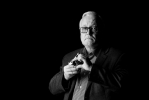Blog
Final results depend on the cooperation between the photographer and make-up artist (19.12.2016)
There are two myths that go along with taking portraits and I am about to bust those myths. It is thought that today's photo processing enables everything – combing hair, lip makeup and shaping eyebrows. That everything can be done quickly and easily in the computer. The other myth is that when the model has perfect make-up, there's no need for the photographer to make an effort behind the camera and in front of the computer screen – beautiful portraits are born just like that.
Hobby photographers often shoot their models without using a make-up artist. Make-up is often done by the model herself. What are the common mistakes? First of all, the lens needs to be right. Lenses with longer focal length more than 50mm are most often used for taking portraits. The focal length of a classical portrait lens is 85mm. Nikkor offers two possibilities: NIKKOR AF-S 85mm f/1.4G or a bit cheaper but also high quality NIKKOR AF-S 85mm f/1.8G.
Secondly, you need to consider the light you have in your hands. For example, if you are using flash light, then this kind of light brings out the defects very well. Since this kind of light has a lot of contrasts, any hair or bumpiness on the skin is going to have a contrast shadow because the light falls under an angle. If the make-up artist pushes facial hair up by applying make-up against the hair, all these are going to visible on the photo
The same goes for toning make –up. Here, hairline is the problematic area. If the make-up ends as a strict line before the hair, it is not going to look beautiful and changing these flaws during photo processing is time-consuming and the results are not always the best. With make-up, you also have to consider that in addition to the face, the neck is also captured on the photo and depending on the clothes, so are the shoulders and hands. It wasn’t a long ago, when I found myself in a situation where next to a strongly toned face, there suddenly was a pair of white hands in the frame.
Now about the role of the photographer. First of all, the photographer should be aware of the expectations on the final results before the shooting. The photographer is the one managing the situation. The ability to notice the possible flaws during the shoot is much better than trying to fix something later during photo processing. How the light works with the model and her make-up is up to the photographer.
When photographing men, a more contrast light and stronger shadows are used. How to describe the face with light, add masculinity? Cooperation between the photographer and the light should match with the overall emotionality of the photo. Dark tones and deep shadows may emphasise negative emotions, bright and light tones add positivity. By the way, there is one little helper that is used to photograph make-up and I recommend it. RoundFlash Ring Light is an additional device that is used together with the speedlight. It goes perfectly with SB-700. It also goes with newer generation speedlight SB-5000.
By using RoundLash Ring Light, you get a light that is soft and even and which lights the face of the model evenly from every direction. As a result of this, there is no room for the shadows of any of the bumps on the skin. This device is the perfect tool for photographing make-up and achieving extra soft light. It is possible to pack it into a very small package.




